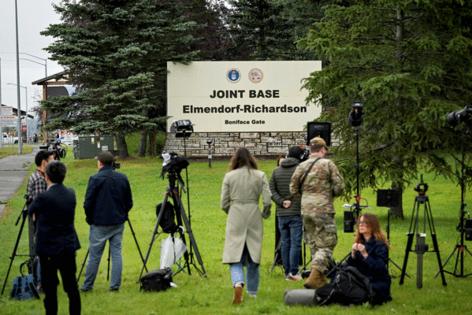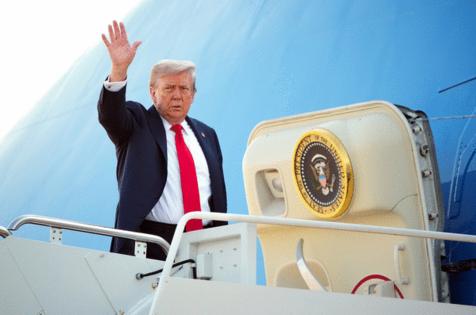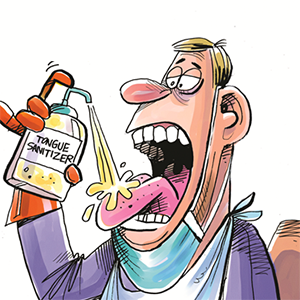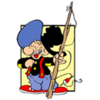Trump and Putin have different goals for Anchorage summit
Published in News & Features
Donald Trump and Vladimir Putin will measure success at their summit in Alaska very differently, even as both leaders are already looking toward a second meeting.
The U.S. president sees any kind of ceasefire in Ukraine as a key objective of the talks. For the Russian leader, getting face time with Trump on American soil without having made any concessions on the war is already a win.
Those are the contrasting stakes as both leaders head to Anchorage for their first summit since 2018 in Helsinki, Finland. The imbalance points to the perils and opportunities for Trump, who has long cast himself as the only one who can end the war. Putin has little incentive to stop the fighting as Russia’s military slowly grinds out gains in Ukraine, but can ill afford to alienate a president with whom he’s long cultivated a relationship.
En route to Anchorage on Friday morning, Trump didn’t rule out that Ukraine might get some form of security guarantees from Western nations, or that it might have to agree to swap land with Russia. But he said it wasn’t his place to decide.
“I’ve got to let Ukraine make that decision,” Trump said of the idea of the two countries trading land. “And I think they’ll make a proper decision. But I’m not here to negotiate for Ukraine. I’m here to get them at the table.”
By invading Ukraine in 2022, Putin began Europe’s biggest war for 80 years and became an international pariah. The summit with Trump helps him to chip away at the isolation the United States and its Group of Seven allies have sought to impose on the Russian leader over his aggression.
Even more symbolically potent is the decision to host the encounter at a military base, Joint Base Elmendorf-Richardson, in the U.S. By that metric, Putin has scored a victory simply by showing up.
The meeting also marks a repudiation of former President Joe Biden’s approach of “nothing about Ukraine without Ukraine,” a mantra that made sure Ukrainian President Volodymyr Zelenskyy always had a seat at the table.
“Russia wants to continue to pursue its objectives, which are to dramatically weaken Ukraine and essentially undermine its independence and sovereignty,” Richard Haass, a former senior State Department official, said in an interview. “So Russia sees negotiations not as an alternative to that, but as a means toward that end.”
The perils for Trump account for the White House’s strategy of tamping down expectations for the meeting. Trump described it as a “feel-out meeting,” a message reinforced by White House press secretary Karoline Leavitt, who called the summit “a listening exercise for the president.”
Trump is already looking ahead to a potential second summit that would include Zelenskyy — and perhaps European leaders — which he anticipated would be “more productive than the first.” The Kremlin, anticipating that move, has invited Trump to come to Russia next.
It’s a far cry from Trump’s boasts on the campaign trail that he could end the war within a day of taking office. In May, Secretary of State Marco Rubio said it was “abundantly clear” that a breakthrough was only possible with involvement of Trump and Putin.
The new framing gives Trump room to maneuver during the actual meeting, according to people familiar with the matter, who asked not to be identified discussing private deliberations. That will allow him to make decisions in the moment as he relies on his instincts, which aligns with his preference for personal diplomacy over traditional bureaucratic deliberations.
In one optimistic scenario, the two leaders could leave Alaska with an agreement to halt the fighting — at least temporarily or partially, for instance by agreeing to pause Russian air attacks.
Trump could boost Putin’s proposal to take Ukrainian territory that his forces have captured. Or they could come away with nothing at all, something Trump was happy to accept after he walked out of talks with North Korea’s Kim Jong Un in 2019.
Trump said in an interview with Bret Baier on Friday that if the meeting does not go well, “I would walk,” according to Fox News.
“I think it’s going to work out very well and if it doesn’t, I’m going to head back home real fast,” he told Baier.
For his part, Putin is eager to widen cracks between the U.S. and Europe while seeking relief from sanctions that have crippled Russia’s economic growth.
The list of attendees reflects the importance both sides attach to the meeting. Trump will be joined by Rubio, Treasury Secretary Scott Bessent and Commerce Secretary Howard Lutnick, as well as his CIA director, John Ratcliffe.
There’s a concern among governments in Europe that rather than focus on Ukraine’s interests, the meeting could pivot to improving the U.S.-Russia economic relationship. That might provide Putin a lifeline to continue the war, according to a European diplomat who asked not to be identified without authorization to speak to publicly.
“Once he gets into the room with Vladimir Putin, and Putin is able to make his case, I think he will be malleable, and the inclination will be to get along with Putin,” Andrea Kendall-Taylor, a senior fellow at the Center for a New American Security, told reporters on Thursday. “I think a lot of the goodwill and agreement with the Europeans may very well go right out the door.”
Trump told reporters on Air Force One he belived Putin would also include economic officials in his delegation.
“I noticed he’s bringing a lot of business people from Russia, and that’s good I like that because they want to do business,” Trump said. “But they’re not doing business until we get the war settled.”
Putin brings his longtime foreign minister, Sergei Lavrov, as well as his defense and finance ministers. That suggests Russia wants to discuss the potential for increased economic cooperation — an idea that appeals to Trump.
Trump and Putin are expected to speak alone ahead of a lunch with their delegations and a joint press conference is planned afterward.
That raises the specter of a repeat of the now-infamous news conference in Helsinki where Trump publicly sided with Putin in rejecting U.S. intelligence assessments that Russia had meddled in the 2016 presidential election.
_____
(With assistance from Hadriana Lowenkron.)
_____
©2025 Bloomberg L.P. Visit bloomberg.com. Distributed by Tribune Content Agency, LLC.










Comments